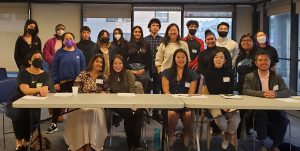
Zachary Seow was always the “therapist friend” to whom his friends confided their troubles. While he enjoyed lending an ear, he realized how people didn’t know how to categorize their feelings. This fueled his desire to major in sociology and eventually become a therapist.
Seow’s goal of a career in mental health is rare among Asian Americans who make up about 5% of America’s mental health practitioners according to Mental Health America. Asian Americans and Pacific Islanders, also known as AAPI, are the least likely to seek mental health care among all racial groups according to the National Alliance on Mental Illness.
“It’s not really talked about, and it’s something that I think my family doesn’t really know about,” said Seow. “As long as we’re able to destigmatize the way we view mental health, especially in the AAPI community, it will become more acceptable.”
The need for AAPI therapists is fervent as the community faced 10,905 reported hate crimes from March 2020 to December 2021 according to Stop AAPI Hate. This triggered a mental health crisis with an increase in depression, anxiety and trauma according to the American Psychological Association.
“I think this time period has sort of intensified past racial trauma for people and forced them to remember things that they may have not thought about in a long time, process or ever really made sense of,” said Gabriela Fullon, a licensed mental health counselor and Asian American studies professor.
Fortunately for aspiring therapists like Seow, the Hunter College AANAPISI Project, also known as HCAP, provides Asian students opportunities to connect with mental health professionals. The program also offers classes about the community’s mental health needs.
“We try to bring conversations about mental health issues in our community to various student events where students can openly discuss queer, gender and race-related stress in the community,” said Marcia Liu, the mental health coordinator of HCAP. “I think the more AAPI young people learn about and become aware of mental health issues in the community, the more we see those folks pursuing mental health-related jobs.”
HCAP also serves AAPI students who are in need of emotional support. Reinalynkate Dimapilis was always interested in mental health services, but couldn’t look for professional help due to the stigma her Filipino family had towards therapy. The mental health events and workshops HCAP offers for students were the next best thing for Dimapilis.
“It was one of the things that felt as though it wasn’t as confrontational as me going to therapy alone, and it felt very comforting since it’s directed towards AAPI students,” said Dimapilis. “Previous panels would have a professor help with techniques like coping and moderating anxiety. So I think they’ve grown a community of people who went through similar things and need similar tools to help them and cope.”
Fullon said the increase of AAPI therapists is important for representation as it depicts community members as healers and in positions of authority. More BIPOC therapists also help with racial matching which can encourage clients to emotionally connect with their caregivers according to the Asia Pacific Education Review.
“A Western therapist who’s not trained in a culturally competent manner may overlook the ways AAPIs’ bodies are telling them that there’s a mental health issue happening,” said Fullon. “That being said, just because someone is AAPI or a person of color does not always mean they will automatically understand the experiences of someone who looks like them, but it is still crucial for there to be more of us in the field.”
Lloyd Fider, a Filipino American clinical social worker, said at an HCAP mental health career panel that AAPI students should consider this career path carefully due to the low pay if they pursue agency work over private practice. However, Fider also said the increase in Asian American therapists can help accommodate the influx of AAPI clients since the start of the pandemic.
“We need you guys because there’s a lot of need out there,” said Fider. “Now that it’s more talked about, people are more aware of it and know there’s no shame in being part of the community.”

